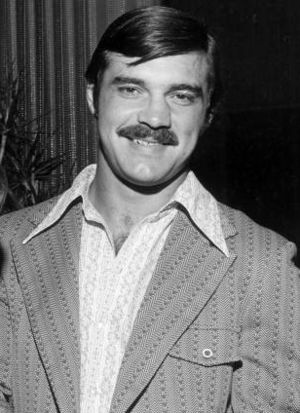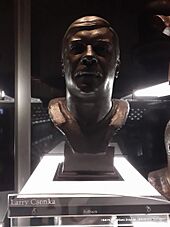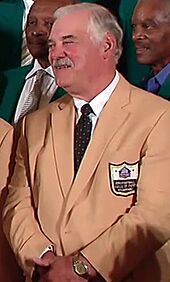Larry Csonka facts for kids

Csonka in 1972
|
|||||||||||||
| No. 39 | |||||||||||||
|---|---|---|---|---|---|---|---|---|---|---|---|---|---|
| Position: | Fullback | ||||||||||||
| Personal information | |||||||||||||
| Born: | December 25, 1946 Stow, Ohio, U.S. |
||||||||||||
| Height: | 6 ft 3 in (1.91 m) | ||||||||||||
| Weight: | 237 lb (108 kg) | ||||||||||||
| Career information | |||||||||||||
| High school: | Stow-Munroe Falls | ||||||||||||
| College: | Syracuse (1965–1967) | ||||||||||||
| NFL Draft: | 1968 / Round: 1 / Pick: 8 | ||||||||||||
| Career history | |||||||||||||
|
|||||||||||||
| Career highlights and awards | |||||||||||||
|
|||||||||||||
| Career NFL statistics | |||||||||||||
|
|||||||||||||
|
Pro Football Hall of Fame
|
|||||||||||||
|
College Football Hall of Fame
|
|||||||||||||
Larry Richard Csonka (born December 25, 1946) is a former professional football player. He was a fullback in the National Football League (NFL). Larry played most of his career with the Miami Dolphins. He also played for the New York Giants and the Memphis Southmen in the World Football League (WFL). People called him "Zonk". Many think Csonka is one of the best running backs ever.
He is famous for his time with the Dolphins. He was part of their amazing 17–0 perfect season in 1972. He also helped them win Super Bowl championships in 1972 and 1973. In Super Bowl VIII, he was named Super Bowl Most Valuable Player (MVP). He ran for a record 145 yards in that game. Larry Csonka was also a commentator for the TV show American Gladiators.
Csonka was chosen for the Pro Bowl five times. He was also a first-team All-Pro three times. He is still the Miami Dolphins' all-time leading rusher. He gained 6,737 yards and scored 53 touchdowns for them. In his last year with the Dolphins in 1979, Csonka won the NFL Comeback Player of the Year Award. He was inducted into the College Football Hall of Fame in 1989. He also joined the Pro Football Hall of Fame in 1987. His jersey number 39 was retired by the Miami Dolphins in 2002.
Contents
Early Life and High School Football
Larry Csonka was born on December 25, 1946. He grew up on a farm in Stow, Ohio. He was one of six children in his Hungarian family.
Csonka started playing football at Stow High School. He was the starting fullback for the Stow Bulldogs. In 1962, his team won the Metropolitan League championship. He played for Stow from 1960 to 1963. He also wrestled in high school.
Larry became a running back by chance. As a sophomore, he played defensive end. In the last game of the year, he was on the kickoff return team. The ball came to him, and he started running. He said he ran over two tacklers before he knew what he was doing. He loved carrying the ball. From then on, he wanted to be a runner.
College Football Career
Many colleges wanted Csonka to play for them. These included Clemson, Iowa, and Vanderbilt. He chose Syracuse. In his first year, he played middle linebacker. From 1965 to 1967, he switched to fullback. He was named an All-American at this position.
He broke many rushing records at Syracuse. Some of these records were held by famous players like Ernie Davis and Jim Brown. In three seasons, Csonka rushed for a school-record 2,934 yards. He ran for over 100 yards in 14 different games. He averaged 4.9 yards per carry. In 1989, he was honored in the College Football Hall of Fame.
Professional Football Journey
Joining the Miami Dolphins
The Miami Dolphins picked Csonka as their first choice in the 1968 Common Draft. He was the eighth player chosen overall. He signed a three-year contract. It included a $34,000 bonus and a car. His salary started at $20,000 a year.
His professional career began with some challenges. In 1968, he got a concussion in a game against Buffalo. He spent two days in the hospital. Later that season, he had another concussion, a ruptured eardrum, and a broken nose. Some wondered if he could keep playing. He missed several games in 1968 and 1969.
When coach Don Shula joined the Dolphins in 1970, he helped Csonka improve. Shula taught him how to run better. Csonka became the Dolphins' offensive leader. He led the team in rushing for the next five seasons. His teammates respected him greatly.
A Tough Runner and Super Bowl Wins
By the 1970s, Csonka was one of the toughest runners in football. He was 6 feet 3 inches tall and weighed 235 pounds. He would often run right through defenders. He dragged tacklers several yards. People called him a "bulldozer" or "battering ram." He rarely fumbled the ball. He was also a great blocker.
Many stories show Csonka's toughness. He broke his nose about ten times during his career. He would keep playing even with blood flowing. In a 1970 game, he knocked out a safety with a forearm hit. In 1972, he was hit hard in the back. He crawled off the field, but then walked it off and returned to the game. His return was key to a winning touchdown. He was named one of the "10 Toughest Players" by NFL Films.
The Dolphins had one of the best running attacks in the early 1970s. They led the NFL in rushing in 1971 and 1972. In 1972, they set a new rushing record with 2,960 yards. Csonka ran for 1,117 yards that season. His teammate Mercury Morris ran for exactly 1,000 yards. They were the first pair of teammates to each rush for over 1,000 yards in NFL history.
This strong running game led the Dolphins to three straight Super Bowls. They won Super Bowl VII and Super Bowl VIII. Csonka's powerful style helped the Dolphins control the ball. He ran through defenders instead of around them. He had three straight 1,000-yard seasons from 1971 to 1973. In 1971, he averaged 5.4 yards per carry, leading the NFL.
In 1972, the Dolphins became the only NFL team to have a perfect undefeated season. Csonka was a huge part of this success. He led all rushers in Super Bowl VII with 112 yards. In Super Bowl VIII, he was the MVP. He rushed for a record 145 yards and two touchdowns.
Csonka and his teammate Jim Kiick were known as "Butch Cassidy and the Sundance Kid." In 1973, Csonka and Kiick wrote a book called Always on the Run. The book shared stories about their childhoods and playing professional football.
Playing in the WFL and Return to the NFL
In 1974, Csonka, Kiick, and Paul Warfield signed contracts to play in the new World Football League (WFL). Csonka signed a three-year deal for $1.4 million. They played for the Memphis Southmen. However, the WFL had money problems and folded during its second season. Csonka played only one season in the WFL.
As a free agent, Csonka joined the New York Giants in 1976. He tore ligaments in his knee, ending his first season early. He blamed the injury partly on the artificial turf of Giants Stadium. He has always spoken out against artificial turf.
In 1978, Csonka was on the field for a famous play called "The Miracle at the Meadowlands." With seconds left, the Giants made a mistake on a handoff. The Philadelphia Eagles recovered the ball and scored the winning touchdown.
After that season, Csonka's contract with the Giants ended. He returned to the Miami Dolphins in 1979. He ran for over 800 yards, his best since the Super Bowl years. He also scored a career-high 12 rushing touchdowns. Csonka won the Comeback Player of the Year award for his great 1979 season. He retired after that year.
In his 11 NFL seasons, Csonka carried the ball 1,891 times for 8,081 yards. He scored 64 rushing touchdowns. He also caught 106 passes for 820 yards and four touchdowns. He was named All-Pro three times and played in five Pro Bowls.
NFL Career Statistics
| Legend | |
|---|---|
| Led the league | |
| Won the Super Bowl | |
| Super Bowl MVP | |
| Bold | Career high |
Regular season
| Year | Team | Games | Rushing | Receiving | Fum | |||||||||
|---|---|---|---|---|---|---|---|---|---|---|---|---|---|---|
| GP | GS | Att | Yds | Avg | Lng | TD | Rec | Yds | Avg | Lng | TD | |||
| 1968 | MIA | 11 | 10 | 138 | 540 | 3.9 | 40 | 6 | 11 | 118 | 10.7 | 65 | 1 | 1 |
| 1969 | MIA | 11 | 11 | 131 | 566 | 4.3 | 54 | 2 | 21 | 183 | 8.7 | 42 | 1 | 3 |
| 1970 | MIA | 14 | 14 | 193 | 874 | 4.5 | 53 | 6 | 11 | 94 | 8.5 | 54 | 0 | 3 |
| 1971 | MIA | 14 | 14 | 195 | 1,051 | 5.4 | 28 | 7 | 13 | 113 | 8.7 | 25 | 1 | 0 |
| 1972 | MIA | 14 | 14 | 213 | 1,117 | 5.2 | 45 | 6 | 5 | 48 | 9.6 | 14 | 0 | 2 |
| 1973 | MIA | 14 | 14 | 219 | 1,003 | 4.6 | 25 | 5 | 7 | 22 | 3.1 | 9 | 0 | 3 |
| 1974 | MIA | 12 | 11 | 197 | 749 | 3.8 | 24 | 9 | 7 | 35 | 5.0 | 11 | 0 | 2 |
| 1975 | MEM | 99 | 421 | 4.3 | 13 | 1 | 5 | 54 | 10.8 | 25 | 1 | |||
| 1976 | NYG | 12 | 12 | 160 | 569 | 3.6 | 13 | 4 | 6 | 39 | 6.5 | 14 | 0 | 2 |
| 1977 | NYG | 14 | 13 | 134 | 464 | 3.5 | 15 | 1 | 2 | 20 | 10.0 | 12 | 0 | 0 |
| 1978 | NYG | 14 | 12 | 91 | 311 | 3.4 | 12 | 6 | 7 | 73 | 10.4 | 23 | 0 | 0 |
| 1979 | MIA | 16 | 16 | 220 | 837 | 3.8 | 22 | 12 | 16 | 75 | 4.7 | 18 | 1 | 4 |
| Career | 146 | 141 | 1,891 | 8,081 | 4.3 | 54 | 64 | 106 | 820 | 7.7 | 65 | 4 | 21 | |
Life After Football

After retiring from football, Larry Csonka became a motivational speaker. He also hosted several hunting and fishing TV shows. He appeared on The Ed Sullivan Show and had a role in the 1970s TV show Emergency!. He played Commander Delaney in the 1976 movie Midway.
Csonka worked for the United States Football League (USFL) Jacksonville Bulls in the mid-1980s. He was first a director of scouting, then a general manager. He was also a TV analyst for NFL games on NBC in 1988. From 1990 to 1993, he was an analyst for American Gladiators.
Csonka was inducted into the Pro Football Hall of Fame in 1987. His number 39 jersey was retired by the Miami Dolphins in 2002. He is one of 11 Dolphins players and coaches in the Hall of Fame.
Between 1985 and 1990, Csonka started spending time in Alaska. He eventually lived there most of the year. He enjoyed the colder climate compared to Miami's heat.
From 1998 to 2013, Csonka produced and co-hosted North to Alaska. He also had a show called Csonka Outdoors from 1998 to 2005. In 2005, Csonka and five others were rescued by the U.S. Coast Guard. Their boat was caught in a severe storm off Umnak Island in Alaska.
Csonka and his co-host Audrey Bradshaw live in Wasilla, Alaska. He also has a farm in Lisbon, Ohio. He runs Goodrich Seafood House in Oak Hill, Florida. Csonka appears in TV commercials for the Alaska Spine Institute.
In November 2013, Csonka was honored by the Pro Football Hall of Fame. A special plaque was placed in the Stow High School gym. This plaque serves as an inspiration for students and athletes.
Csonka played a fictional version of himself in the HBO series Ballers. In the show, he was named head coach of the Miami Dolphins. He also made a cameo with former Dolphins coach Don Shula on a fishing trip. In 2022, he released his memoir titled Head On.
See also
 In Spanish: Larry Csonka para niños
In Spanish: Larry Csonka para niños
- List of American Football League players


